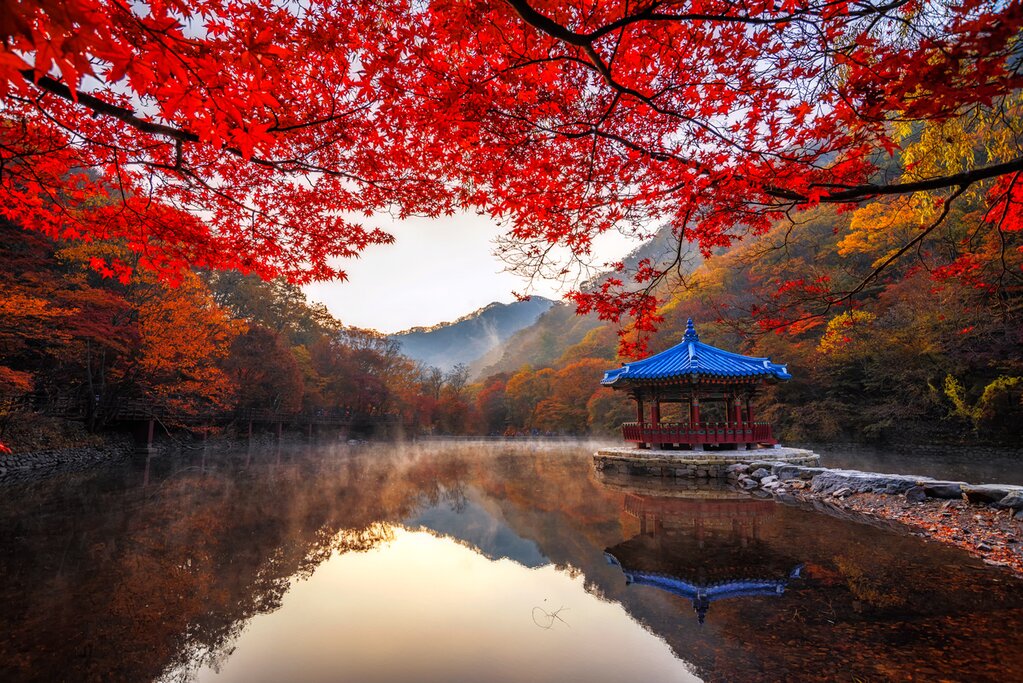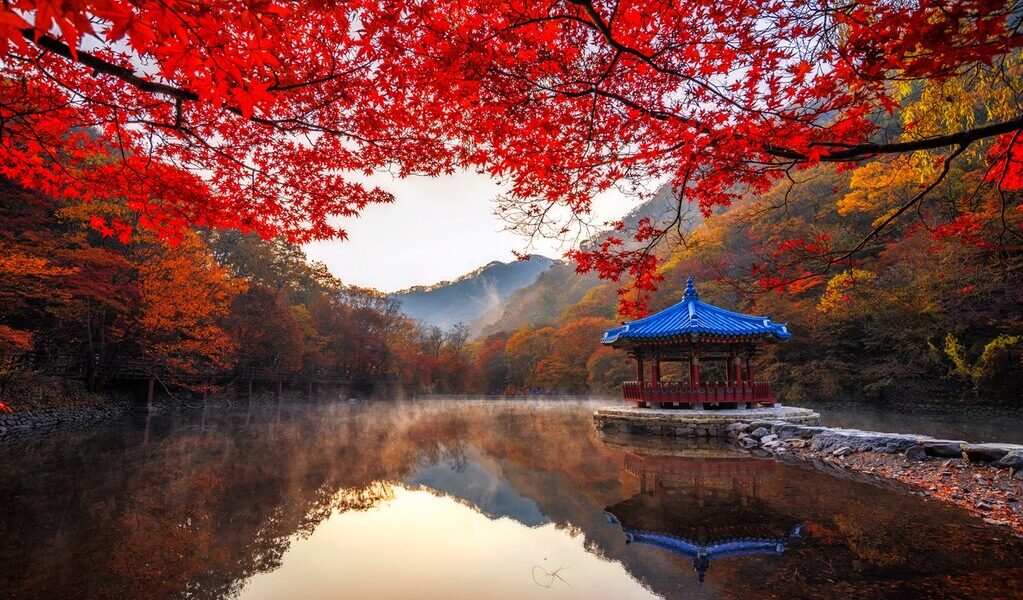
Travel to South Korea in October for stunning autumn views. This month’s pleasant weather and fall foliage attract visitors from across the globe. Take in the changing leaves along a hiking trail at a national park, or enjoy the scenery while sightseeing in Seoul. For a day trip, visit Nami Island, a popular tourist destination year-round that is exceptionally breathtaking in the fall. While crowds can be high this month, October’s popularity is well-deserved: it’s one of the best months to visit South Korea.
## South Korea in October: A Comprehensive Guide to Autumnal Delights
October in South Korea presents a delightful proposition for travelers: a harmonious blend of cool, dry weather and the spectacular beauty of fall foliage. The transition from summer’s warmth is complete, offering comfortable daytime temperatures that are ideal for exploration and outdoor activities. The average high temperature hovers around a pleasant 64°F (18°C), perfect for strolling through parks or embarking on scenic hikes. As the sun begins to dip below the horizon, however, temperatures cool down significantly, typically settling in the mid-40s (Fahrenheit). Therefore, packing layers is strongly recommended to ensure you remain comfortable throughout your adventures, especially during evening excursions. A light sweater, jacket, or even a scarf will prove invaluable as you embrace the crisp autumn air.
Rainfall and humidity continue their seasonal decline throughout October, further enhancing the appeal of outdoor pursuits. The capital city of **Seoul** experiences a monthly average of only 2 inches (52 mm) of rain, contributing to the prevalence of clear skies and bright, sunny days. These favorable weather conditions create an idyllic setting for immersing yourself in the natural beauty and cultural richness that South Korea has to offer.
Beyond the comfortable temperatures and reduced rainfall, October holds another special allure: it marks the peak of the fall foliage season in South Korea. The transformation begins subtly in late September, as the leaves gradually transition from vibrant greens to a kaleidoscope of reds, oranges, and golds. This breathtaking spectacle unfolds throughout the month of October and extends into mid-November, when the arrival of winter weather brings the season to a close. While the colorful leaves can be enjoyed throughout October, the most captivating and dramatic displays typically occur during the middle and latter part of the month. To maximize your chances of witnessing peak autumnal views, it is advisable to research the forecast for peak foliage dates, as these can vary from year to year and are also dependent on geographical location.
The popularity of October as a travel month in South Korea is driven by the combination of optimal weather conditions and the enchanting fall foliage season. These factors draw visitors from across the globe, all eager to experience the country’s autumnal charm. Consequently, during the peak foliage period, which typically spans the middle to late part of October, popular sightseeing destinations can become quite crowded. Places like **Nami Island**, famed for its picturesque landscapes, and South Korea’s numerous national parks experience particularly high visitor numbers. Hikers should anticipate busy trails, and those traveling to the national parks should expect increased traffic congestion. To mitigate the impact of the crowds, consider adopting strategies such as arriving early at your chosen destinations to secure parking and beat the rush.
Increased demand during this peak season also affects travel costs. Flight and accommodation prices tend to rise as visitor numbers surge, although the rates typically remain lower than those encountered during the peak summer travel season. Planning and booking your trip in advance can help you secure better deals and avoid last-minute price hikes.
Choosing the ideal location for autumn sightseeing in South Korea depends largely on the timing of your visit. Early in the season, the vibrant colors of fall first emerge in the northeastern regions of the country. Therefore, a trip to **Seoraksan National Park** at the beginning of October is highly recommended. This magnificent park boasts over thirty individual peaks, each adorned with a stunning array of red and gold leaves. The views are truly spectacular and provide an unforgettable introduction to the beauty of the South Korean autumn.
As the month progresses, the peak foliage gradually shifts southward. In the latter half of October, **Naejansan National Park** becomes the prime destination for leaf-peeping enthusiasts. Here, visitors can revel in a final, breathtaking display of red maple and gold ginkgo trees before the leaf-peeping season concludes in November. As with Seoraksan National Park, conducting thorough research before your visit is crucial, as peak dates for fall leaves can fluctuate based on annual weather patterns.
**Nami Island**, a crescent-shaped island situated a short distance from **Seoul** (less than two hours), is another highly recommended destination during October. This island gained fame as the filming location for the beloved 2002 romantic drama television series, “Winter Sonata,” and has since become a popular tourist destination throughout the year. However, it is during the fall season that Nami Island truly shines. Its iconic tree-lined avenues and tranquil riverside walkways provide the perfect setting for a leisurely stroll amidst the stunning autumn foliage. Visitors can access Nami Island via a short ferry ride, or for the more adventurous, a thrilling zipline offers a unique and exhilarating way to reach the island, reaching speeds of up to 35 mph (56 km/h).
October presents the prime opportunity to witness South Korea’s captivating autumn foliage. Many South Koreans seize this opportunity to immerse themselves in the great outdoors, embracing activities like hiking, backpacking, camping, and the increasingly popular “glamping.” However, you don’t necessarily have to venture far from the city to appreciate the beauty of autumn. In the capital city of **Seoul**, consider spending an afternoon exploring the expansive **Seoul Forest Park**, a verdant oasis in the heart of the urban landscape. Alternatively, visit the sprawling **Seoul Olympic Park**, renowned for its over a mile-long rows of majestic golden ginkgo trees. Just a short distance away, in the nearby city of **Incheon**, the **Maple Tree Tunnel** within **Incheon Grand Park** provides picturesque scenery and abundant photo opportunities.
For those seeking a deeper connection with South Korean history and culture, October offers an excellent opportunity to explore the country’s most significant historical and cultural sites. Delve into the past by visiting the eight archaeological sites that comprise the **Baekje Historic Areas**, located in the mountainous mid-west region of the country. Alternatively, embark on a journey to **Gyeongju**, often referred to as the “museum without walls” due to its remarkable collection of 52 UNESCO World Cultural Heritage sites. The **Gyeongju National Park**, a must-visit destination for history enthusiasts, holds the distinction of being the only national historic park in the country. For a more somber and thought-provoking experience, consider joining a guided tour of the **Demilitarized Zone** (DMZ), the heavily guarded “no man’s land” that has separated the two Koreas since the Korean War.
October is also a time for celebration in South Korea, with numerous fall festivals taking place to commemorate the harvest season or honor important historical events. A journey to **Jinju** in **South Gyeongsang Province** will lead you to South Korea’s most famous lantern festival. This event, commemorating a medieval battle against the Japanese, attracts over two million visitors annually who come to witness the mesmerizing sight of hundreds of colorful lanterns floating serenely along the **Namgang River**. Alternatively, visitors can celebrate the abundance of the harvest by indulging in local agricultural products, including rice, coffee, and cheese, at smaller regional festivals held in **Icheon**, **Gangneung**, and **Imsil**.
**Key Events in October:**
* **Jinju Lantern Festival**, **Jinju**: Celebrated at the beginning of October, this famous festival features a stunning display of hundreds of lanterns floating along the Namgang River, accompanied by a captivating parade and a dazzling fireworks show.
* **Gangneung Coffee Festival**, **Gangneung**: A paradise for coffee lovers, this coffee-themed festival offers tastings from coffee shops representing regions across the country, along with engaging masterclass coffee seminars.
* **Suwon Hwaseong Cultural Festival**, **Suwon**: This annual three-day festival, held at the Hwaseong Fortress, a UNESCO World Heritage Site, showcases cultural performances and interactive activities.
* **Icheon Rice Cultural Festival**, **Icheon**: Celebrate Icheon’s renowned rice and local agricultural practices by tasting the “best rice in Korea” and participating in various rice-themed activities.
* **Gwangju Chungjang Festival**, **Gwangju**: Immerse yourself in the vibrant atmosphere of this festival, where Chungjang Street is transformed into a nostalgic representation of the 1970s and 1980s, complete with a lively parade and busking performances.
This detailed guide provides a comprehensive overview of South Korea in October, highlighting the exceptional weather, breathtaking fall foliage, diverse activities, and captivating cultural events that make it an unforgettable travel destination.
B-2314

